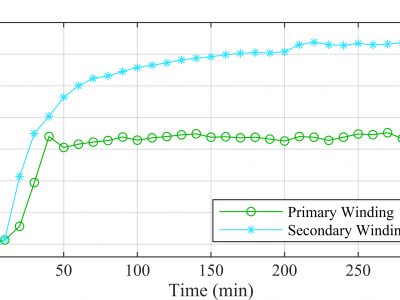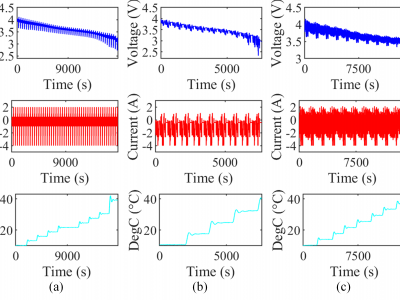Power and Energy

A number of disruptive technologies are expected to impact on future power systems (PS). Electric vehicles (EV), photovoltaic systems (PV), wind turbines (WT), energy storage systems (ESS), vehicle to grid (V2G), and demand response (DR) are seen as those with the most significant potential impact on the PS. Whereas various aspects of the integration of these six technologies into PS are well researched, the technologies are often studied in isolation from each other or in small subsets (e.g. PV and ESS).
- Categories:
 152 Views
152 ViewsA transformer temperature rise test was conducted using a temperature rise recorder (JIK-8/16 Temperature Recorder) under room temperature conditions. With a water flow rate of 10L/min, the input active power was 393.23kW, the input reactive power was 305.64kvar, and the input current was 744.6A. The power loss was 8.5kW, resulting in a power conversion efficiency of 97.8%.
- Categories:
 316 Views
316 ViewsIn the experiments, data is collected through tests on a LIB, specifically the Panasonic NCR186500BD, which has a capacity of 3200 mAh, a voltage of 3.6 V and is used as an energy storage unit by Tesla electric vehicles. To simulate different discharge modes of an EV battery, the Dynamic Stress Test (DST), Beijing Dynamic Stress Test (BJDST), and Federal Urban Driving Schedule (FUDS) are used as test subjects. The tests are conducted at temperatures ranging from 10 °C to 45 °C in the Energy Optimization and Power Security (EOPS) Laboratory at Hunan University, China.
- Categories:
 74 Views
74 Views
This dataset includes the system data and equivalent Distributed Energy Resource (DER) allocations for three test cases: a 10-bus system, the IEEE 69-bus radial test feeder, and an 873-bus radial test feeder. The IEEE 69-bus system data is based on the work of Baran and Wu ("Optimal capacitor placement on radial distribution systems," IEEE Trans. Power Deliv., vol. 4, no. 1, pp. 725-734, 1989).
- Categories:
 508 Views
508 Views
This paper presents a method for modeling and simulating three-phase grid-connected solid-oxide fuel cell systems in the Matlab/Simulink environment. The approach is utilized to analyze the interaction between solid-oxide fuel cells and the electrical power system, focusing on understanding the dynamics of the electrochemical reaction and its impact on the performance of grid-connected fuel cell systems. The results highlight the effectiveness of the proposed method in accurately modeling and operating three-phase grid-connected solid-oxide fuel cell systems.
- Categories:
 173 Views
173 Views
MatWPT is an innovative software to support designers during the analysis and development of Wireless Power Transfer (WPT) systems. The software, developed as a Matlab toolbox, receives the key system characteristics as inputs, such as compensation topology, operating frequency and desired output power. Then, using evolutionary optimization, provides potential design options for meeting the performance criteria defined by the designer, in terms of output power and efficiency.
- Categories:
 70 Views
70 Views
Accurately detecting power line defects under diverse weather conditions is crucial for ensuring power grid reliability and safety. Existing power line inspection datasets, while valuable, often lack the diversity needed for training robust machine learning models, particularly for adverse weather scenarios like fog, rain, and nighttime conditions. This paper addresses this limitation by introducing a novel framework for generating synthetic power line images under diverse weather conditions, thereby enhancing the diversity and robustness of power line inspection systems.
- Categories:
 259 Views
259 ViewsThis research focuses on simulating a transformer
using electromagnetic field solver software: FEMM and COMSOL
Multiphysics®. These tools are used to simulate and extract
the model of a three-winding transformer. The primary objective
of the extracted model is to predict key magnetic parameters,
such as leakage and magnetizing inductances. These inductances
play a critical role in switch-mode power converter topologies,
ensuring proper operation and achieving high efficiency through
- Categories:
 81 Views
81 Views
Different countries have various grid voltages, and different electric vehicles (EVs) have different chassis heights. Conventional EV wireless power transfer (WPT) solutions require designing different circuits for various input voltages and using different compensation circuits for different transmission distance classes which hinders the widespread adoption of the WPT technique. To address these two issues, this paper proposes an EV WPT system based on series-parallel inverters. The mathematical model of this system is established, and the expression for output power is derived.
- Categories:
 94 Views
94 Views

